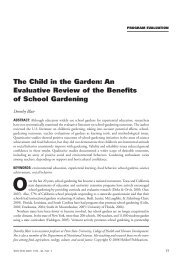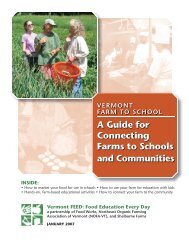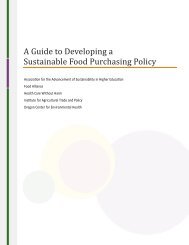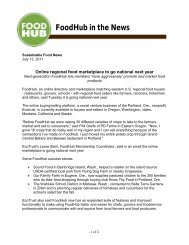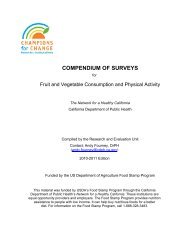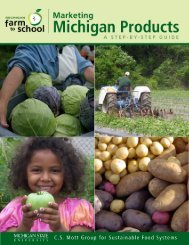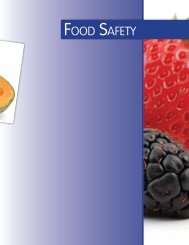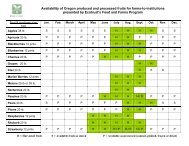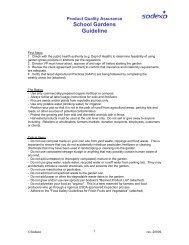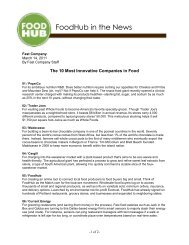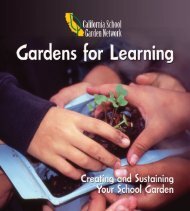eval report cover.indd - New Jersey Farm to School Network Wiki
eval report cover.indd - New Jersey Farm to School Network Wiki
eval report cover.indd - New Jersey Farm to School Network Wiki
Create successful ePaper yourself
Turn your PDF publications into a flip-book with our unique Google optimized e-Paper software.
Review of <strong>Farm</strong> <strong>to</strong> <strong>School</strong> Evaluation LiteratureFood Service ImpactsMany farm <strong>to</strong> school programs start from and are rooted in changes <strong>to</strong> thecafeteria offerings, which may require modifications <strong>to</strong> the food service program.In order <strong>to</strong> use local product, school food service may need <strong>to</strong> employadditional workers <strong>to</strong> wash, cut, and prepare freshly harvested produce, or processother local products before they can be offered on the cafeteria line. The support ofthe food service direc<strong>to</strong>r and cafeteria staff is crucial <strong>to</strong> the success of a farm <strong>to</strong> schoolprogram.Nine of the programs studied assessed the impacts of farm <strong>to</strong> school programs on foodservice operations. With an improvement in cafeteria food quality and taste, these studies<strong>report</strong> an increase in overall school meal participation rates in the range of 3 -16%.More specific impacts on the food service operations are listed below:<strong>Farm</strong> <strong>to</strong> school programs offer greater variety and quantities of fruits and vegetables<strong>to</strong> students►►►Trend data available from 2002-06 for the CLP-CA program shows that the farm<strong>to</strong> school salad bar offered a wider variety of fruits and vegetables than the hotlunch option. 80 In 2004-05, the salad bar offerings contributed, on average, 87%of the USDA recommended daily requirements of fruits and vegetables for children.18 During the 2004-05 school year, students eating farm <strong>to</strong> school salad barwere offered an average of 105% of the recommended daily serving of fruits andvegetables during lunch – almost twice as much as students eating hot luncheswho were served an average of 58% of the recommended servings. 19Students in the Winters Unified <strong>School</strong> District Program (WSD-CA) eatingthe farm <strong>to</strong> school salad bar meal during the 2003-2004 and 2004-2005 schoolyears were served between 107% and 177% of the recommended daily servingsof fruits and vegetables. 18Th e <strong>School</strong>FoodPlus program in <strong>New</strong> York (SFP-NY) <strong>report</strong>ed that by the endof school year 2004-05, thirty-two <strong>School</strong>FoodPlus plant-based recipes hadbeen created, tested, and served as part of the school menu cycle with varyingfrequency on a citywide basis. From December 2004 <strong>to</strong> June 2005, these recipes81, 82appeared on the citywide menu cycles 97 times.<strong>School</strong> meal participation rates increase when schools implement farm <strong>to</strong> schoolprograms►Th e CLP-CA program recorded an increase of 7% <strong>to</strong> 11% in student participationin the lunch program at schools introducing farm <strong>to</strong> school salad bars.Overall participation in the salad bar lunches ranged from a low of 23% <strong>to</strong> a highof 41%, with an overall average of 32.4% of enrollment; in comparison <strong>to</strong> 26%participation before the salad bars were introduced. 8042 Bearing Fruit: <strong>Farm</strong> <strong>to</strong> <strong>School</strong> Evaluation Resources and Recommendations



